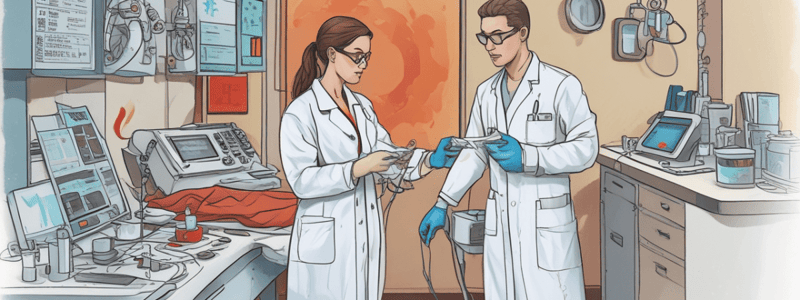Podcast
Questions and Answers
What is the main reason why arterial punctures are considered risky?
What is the main reason why arterial punctures are considered risky?
- The physician is not skilled enough
- The blood is under pressure (correct)
- The patient may experience pain
- The blood sample is difficult to collect
What type of blood gases are typically collected through arterial puncture?
What type of blood gases are typically collected through arterial puncture?
- Insulin and Glucose
- Urea and Creatinine
- Cholesterol and Triglycerides
- Oxygen and Carbon Dioxide (correct)
What is the purpose of evacuated tubes in venipuncture?
What is the purpose of evacuated tubes in venipuncture?
- To analyze blood gases
- To collect blood samples from arteries
- To collect blood samples from veins (correct)
- To collect blood samples from capillaries
What type of physician involvement is required for arterial puncture?
What type of physician involvement is required for arterial puncture?
What type of tool is used in capillary puncture?
What type of tool is used in capillary puncture?
What is the common site for arterial puncture?
What is the common site for arterial puncture?
What is capillary puncture typically used for?
What is capillary puncture typically used for?
What is a characteristic of lancets used in capillary punctures?
What is a characteristic of lancets used in capillary punctures?
What is a advantage of capillary puncture over venipuncture?
What is a advantage of capillary puncture over venipuncture?
What is the purpose of evacuated tube system in venipuncture?
What is the purpose of evacuated tube system in venipuncture?
What is the purpose of a tourniquet in venipuncture?
What is the purpose of a tourniquet in venipuncture?
What is the difference between a 25G and a 21G needle?
What is the difference between a 25G and a 21G needle?
Which of the following is not a type of syringe used in venipuncture?
Which of the following is not a type of syringe used in venipuncture?
What is the purpose of gauze in phlebotomy?
What is the purpose of gauze in phlebotomy?
Flashcards are hidden until you start studying
Study Notes
Phlebotomy Overview
- Phlebotomy involves collecting blood samples from patients through different methods
- Three main methods of blood collection: arterial puncture, capillary puncture, and venipuncture
Arterial Punctures
- Collected by physicians
- Risky due to blood being under pressure
- Used for arterial blood gases, acidity, alkalinity, oxygen, and carbon dioxide tests
- Common sites: radial, brachial, and femoral arteries
- Indications: urgent ABG tests, e.g., accident victims with chest injuries, comatose patients, or patients with severe breathing problems
Capillary Punctures
- Uses different types of materials: lancets (simple and retractable), automatic (pen devices), and adjustable depths
- Advantages: small volume of blood, less invasive, and rapid tests/POCT
- Disadvantages: small volume of blood
- Performed perpendicular to the skin, with "milking" technique
- Different sites for different patients, easier to acquire and perform
Venipunctures
- Uses different types of syringes: slip tip and luer lock
- Syringe sizes: 3 ml, 5 ml, 10 ml, and 20 ml
- Needle sizes: 21G, 22G, 23G, and 25G (smaller gauge means larger diameter)
- Needle lengths: 1 inch and 1.5 inch
- Vacutainer hubs for evacuated tube system
- Advantages: large volume of blood, accurate results
- Disadvantages: more invasive than capillary punctures
Other Phlebotomy Materials
- Capillary punctures: gauze (wet and dry), iodine tincture, lancets, micro-capillary tubes, paediatric blood tubes, regular blood tubes, and rapid/POCT devices
- Venipuncture syringe method: needles, syringes, gauze (wet and dry), iodine tincture, lancets, regular blood tubes, blood culture bottles
- Other materials: tourniquet, spot bandages, bio bins, and sharp disposal bins
Studying That Suits You
Use AI to generate personalized quizzes and flashcards to suit your learning preferences.




